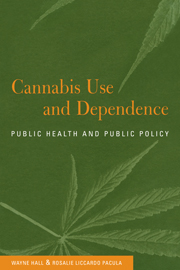Book contents
- Frontmatter
- Dedication
- Contents
- List of figures and tables
- Foreword
- Acknowledgements
- 1 Introduction
- Section 1 Cannabis the drug and how it is used
- Section 2 The health effects of cannabis
- Section 3 The psychological effects of chronic cannabis use
- Section 4 Effects on adolescent development
- Section 5 Harms and benefits of cannabis use
- Section 6 The effectiveness and costs of cannabis prohibition
- Section 7 Policy alternatives
- Appendix 1
- Appendix 2
- References
- Index
Appendix 2
Published online by Cambridge University Press: 05 July 2016
- Frontmatter
- Dedication
- Contents
- List of figures and tables
- Foreword
- Acknowledgements
- 1 Introduction
- Section 1 Cannabis the drug and how it is used
- Section 2 The health effects of cannabis
- Section 3 The psychological effects of chronic cannabis use
- Section 4 Effects on adolescent development
- Section 5 Harms and benefits of cannabis use
- Section 6 The effectiveness and costs of cannabis prohibition
- Section 7 Policy alternatives
- Appendix 1
- Appendix 2
- References
- Index
Summary
The assumption that drugs and crime are causally related is a major reason for prohibiting the use of illicit drugs in many developed countries. In the case of cannabis, however, the evidence for this assumption is much less compelling than it is for heroin and cocaine.
Cannabis, like most other illegal substances, may be associated with crime for two reasons. The first possibility is that cannabis use generates crime. The second reason is a simple consequence of cannabis prohibition: because cannabis use is illegal its use is a crime by definition. We focus on the first of these possibilities in this appendix.
Studies in the United States, England and Australia all show that approximately 60% of arrestees test positive for cannabis (Taylor and Bennett, 1999; Makkai et al., 2000). These data indicate that criminals use cannabis but they do not necessarily mean that cannabis is a cause of crime. First, very few arrestees only test positive for cannabis; most also use other illicit drugs and alcohol that may motivate criminal behaviour (Taylor et al., 2001). Second, a positive urine sample for THC only indicates that the drug has been used in the past month; it does not indicate that cannabis was used at or near the time of the criminal activity that led to arrest.
Surprisingly few studies have examined the relationship between cannabis use and crime. Most of these have examined the relationships between crime and other illegal drugs that have been more closely linked to crime, namely, heroin and cocaine. We review this limited evidence in the light of four hypotheses that have been used to describe the relationship between crime and other illicit drugs (Goldstein, 1985).
The psychopharmacological model
According to the psychopharmacological model, drug users engage in crime because of the acute psychoactive effects of the substance (Goldstein, 1985). There is very little support for this model in the case of cannabis. Laboratory studies generally show that cannabis, unlike alcohol, temporarily inhibits aggression and violence (Miczek et al, 1994; White and Gorman, 2000). These findings raise doubts about the psychopharmacological hypothesis.
- Type
- Chapter
- Information
- Cannabis Use and DependencePublic Health and Public Policy, pp. 236 - 239Publisher: Cambridge University PressPrint publication year: 2002



